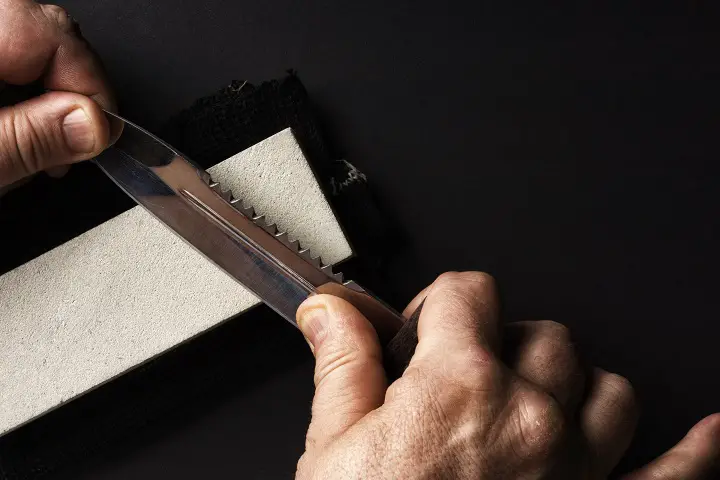
If you are looking for a survival knife with a comfortable grip, then one of your best choices is the serrated knife. Many consider it as a great choice for the world’s best multi-tool because of its several uses. To maximize the benefits, make it a point to learn a thing or two about how to sharpen it. With that, you have an assurance that you will be able to put it to good use all the time.
What Is a Serrated Knife
A serrated knife is a kind of knife with a unique design. Also called a bread knife, you can easily distinguish the knife with the edge of its blade that has a saw-like look. The fact that it has such a design makes this type of knife effective in certain forms of cutting. You can expect it to slice through food with ease, even those with resistant or thick outer surfaces.
This type of knife features a powerful and long blade known to grip food quickly. This blade also has enough strength that it is capable of slicing through everything that is in its path. It can also cut through ropes, belts, fabric, as well as a wide range of textured materials.
It is also effective in cutting soft and flexible substances as well as those you can easily crush through downward cutting. Aside from bread, you will also find this knife useful in cutting cooked meat, vegetables, and soft fruits.
Benefits of Using a Serrated Knife
Can Cut Through Tough Materials
This is the main reason why many consider this as a great choice for sharp hunting knives. It can cut tough materials because of the increased pressure it has. Even fibrous and thick materials can be sliced through by the serrated knife. The knife features serrated edges that promote ease in gripping or grabbing the surface of the object you are cutting with ease.
Quickly Punctures and Tears on Targeted Objects
You can expect even those knives with dull serrations to work excellently when it comes to slicing whatever object you are targeting. This capability is one reason why a lot of people are in favor of serrations. Most users also agree that this type of knife tends to remain sharp for a longer period.
Cuts Better Compared to Knives With Plain Edges
It is mainly because of the thinner serrations used in the serrated knife. With that, you can expect it to do a much better job in cutting objects when compared to those with plain edges.
Can Efficiently Cut Foods That Have Tough Skin
If you need to cut foods with somewhat tough skin, then you can always seek the aid of a serrated knife. Among those foods that have tough skin that it can easily cut through are citrus fruits, tomatoes, and cucumber. It does a pretty good job of cutting fine slices of tomatoes with ease. You can also use it to cut slices of lime or lemon.
How Does a Serrated Knife Work
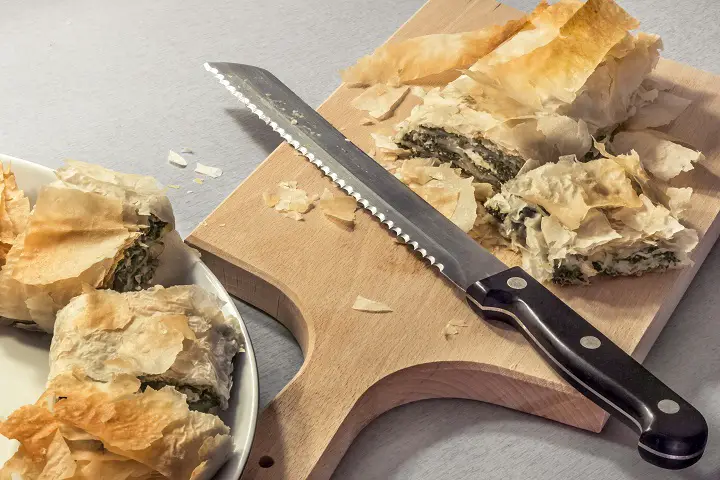
In the same way, as kayak sails work best for beginners, the serrated knife also seems to work well even for those who are just beginners of using it. This knife functions with the help of its serrated edge, which does a good job in slicing and cutting, especially through tough and hard surfaces. It is mainly because of the serrations that cut and grab the surface with ease.
This knife boasts of a cutting power caused by its serrated format. With this cutting power, you have an assurance that even those knives with dull serrated edges will still do a competent job in slicing and cutting. For it to work, the serrations’ high points can be expected to touch the target material first. This can provide such points with a much higher pressure per area compared to using a plain-edged knife with similar pressure.
Because of such high pressure, the serration will perform well when it comes to puncturing easily. The blade of this knife also has two parts designed in a way that they can handle various parts of cutting. The serrations can break through the exterior edge while the remaining blade can be expected to follow through when slicing.
Tools for Sharpening a Serrated Knife
Just like when using the best electric fillet knife, you also need to use some tools designed to sharpen a serrated knife. Among the tools that seem to do a good job in sharpening serrated knives are the following:
Electric Sharpeners
One of the most effective tools that you can use is the electric sharpener. An advantage of an electric sharpener is that unlike other tools meant, this one comes equipped with built-in guides. You will find these guides useful in setting the knife’s angle easily. It works great not only for serrated knives but also when it comes to sharpening other kitchen knives, especially those with similar edge angles.
Ceramic Honing Rod (Sharpening Rod)
Another incredible choice is the ceramic honing rod. While it is extremely hard and time-consuming to use it for sharpening a knife with serration, many still prefer it because of its low price. It also seems to produce the most desirable results for knives that were not sharpened for quite a long time already and for those with bent points.
Trout spinning rods are extremely accurate, making them beneficial for users. You can also expect the ceramic honing rod to produce plenty of favorable benefits to those who decide to use it, such as the fact that it is harder compared to steel and that it has the ability to sharpen scallops. The fact that the ceramic rod is also very fine at approximately 1,000 grit also makes it effective in sharpening your knife.
Triangle-Shaped Sharpener
You can also use a triangle-shaped sharpener. This sharpener comes in the form of a tapered triangle specifically designed for a serrated knife. It has a shape that tends to work favorably on knives that have V-shaped gullets, too.
Square Stone
Although slightly more challenging to use compared to other serrated knife sharpening tools, the square stone is still worthwhile to try. To use it, you have to hold your knife’s spine tightly against an object. Make sure that this object is hard. An example would be the square stone’s edge. Allow the edge to perfectly fit within the scallop then move your knife back and forth gradually.
Sharpening System
You can also use a sharpening system. One of the sharpening systems that you can use is that with several different sharpening stones. This stone often has a built-in knife clamp, which works by holding the knife securely when sharpening it. The system is complete with a guide, which lets you pick the right angle for the blade.
Other features of a good sharpening system are honing oil, finger grips that assure you of a more secure hold for your knife, and a color-coding feature designed to let you know which ones are finer and coarser.
How to Sharpen a Serrated Knife With an Electric Sharpener
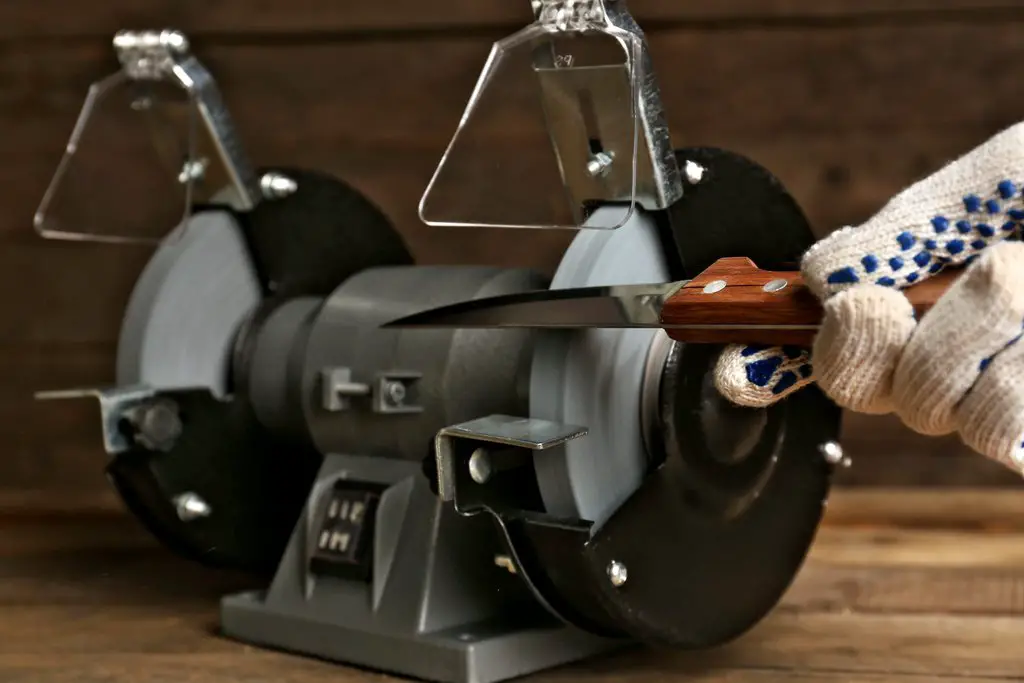
Step 1 – Read and go over the instructions
This will give you an overview of what you should and should not do when sharpening your serrated knife with it. If you are using an electric sharpener with three stages, then you will most likely be using the third stage, which is considered as the finest grit. You can expect this stage to polish or hone the edge in the same way as a leather strap.
Step 2 – Put the blade on the third stage’s guides
Draw the blade’s whole length using the sharpener for four to five times per side. Alternate the sides every time.
How to Sharpen a Serrated Knife with a Sharpening Rod
Just like when you need to use a strong rod when catching a catfish, it is also necessary for your sharpening rod to be tough and high in quality to ensure that it will do a great job in sharpening your rod. Be resourceful when making your choice to increase your chances of buying the best one. Once you have taken hold of a high-quality sharpening rod, perform the following steps:
Step 1 – Find the side which has a beveled edge
Note that, in most cases, serrated knives do not have similar looks from both sides. You can see the face of its blade continuing at a similar angle up to the edge on one side. On the other side, you can see the blade’s face is angled down a bit before the serrations. This serrated edge is referred to as a bevel. Only put on the sharpening tool at the beveled edge.
Step 2 – Put the rod in a serrated scallop or gullet
Make sure to pick an angle, which guarantees ease for the serrated blade. It should be around 13 to 17 degrees in comparison to the blade’s edge.
Step 3 – Move the sharpening rod to match the diameter of the gullet
If you have a tapered rod, then make it a point to find the rod within the gullet. It should be at that specific point where the diameter of the rod has a similar size to the gullet.
Step 4 – Look for a burr
Let your fingers run along the back of the groove so you can check the metal shaving or burr. If you sensed it, then it is a sign that you were able to sharpen the groove adequately. Let your finger run along the back edge. A burr is around in case you feel like there is a catch when doing so.
Step 5 – File all burrs or metal shavings away
Use fine-grit sandpaper to rub the knife’s back part as a means of removing the burrs.
Step 6 – Sharpen all straight edges of the blade
In case the knife has serrations only at one portion of the blade, use a whetstone in sharpening the remaining length.
How to Sharpen Serrated Knife With Other Tools
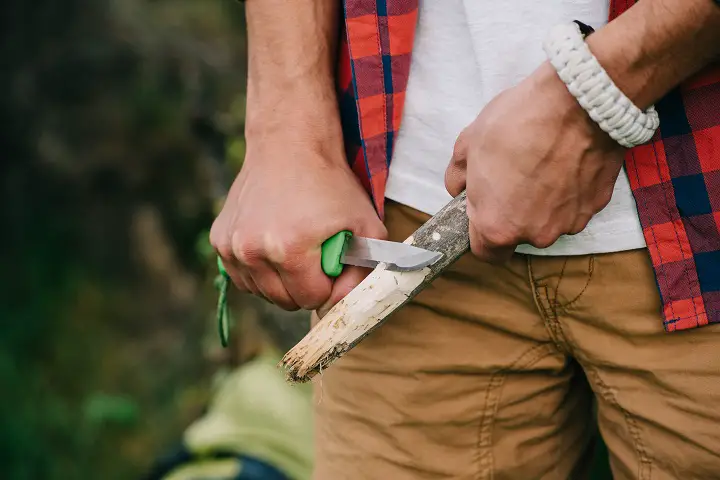
You can also use other tools for sharpening the serrated knife. One tip is to create your own sharpening tool with the help of emery cloth and dowels. Here’s how to use it:
Step 1 – Put every dowel on the first scallop
Buy emery cloth and a few dowels so you can create the sharpening tool. Figure out which one of these dowels sit perfectly. Use the emery cloth to wrap the dowel. Once done, you can use it to sharpen your knife.
Step 2 – Use the sharpening tool made of dowel and cloth
What you should do is to hold it while sharpening the knife’s serrated edges.
A ceramic sharpening rod is also another of the tools you can use. The good news is that this tool is easy to use when it comes to sharpening serrated knives.
Step 3 – Look for a ceramic rod in any hardware store
Make sure that your chosen rod perfectly sits on your knife’s fullest. Prepare the rod then put it in the first groove.
Step 4 – Let it move back and forth gradually
Do the same steps until you noticed that you were able to sharpen the grooves perfectly.
How to Sharpen a Serrated Knife Manually
If you want to sharpen your serrated knife on your own or manually, then go for a ceramic honing rod. It is harder compared to steel honing rods, which is the reason why the ceramic material has the ability to get rid of some materials from the knife blade’s edge.
The good thing about the rod is that it is shaped in a way that it can perfectly fit within the blade’s serrations. To sharpen your serrated knife manually with this ceramic honing rod, follow these steps:
Step 1 – Begin the process at the knife’s end
Put the rod on the serrated groove. Set the rod in a position where it perfectly matches the chiseled cut’s beveled angle you can find in the groove. Fortunately, you will not have a hard time locating such an angle.
Step 2 – Let the honing rod slide through the groove
It should be towards the blade’s edge, which performs the cutting. Make sure to do this step for every groove or gullet.
Do’s and Don’ts When Using a Serrated Knife
- Handle every serration separately or individually when sharpening the knife. Make sure to think of each serration as an individual or separate curved edge, which is put together on a single blade side by side. You need to sharpen each one to ensure that the knife, in its entirety will be able to cut on a wide range of objects effectively.
- Use a sharpener, which perfectly matches the sizes of the serration. It should be the exact match or at least close to the size of the serrations. This assures you that it will be able to sharpen your knife more effectively.
- Apply slow and smooth movements when working with a rod. When using a rod, make sure to do so using smooth and slow movements away from your knife. You only need to apply light pressure.
- Do not use sharpeners that are larger than the serrations. It would be okay to use sharpeners that are small than the knife’s serration, although they should still be closer to the size. However, it would not be ideal to use a larger one than serrations because this might not work.
- Do not rub the rod back and forth. Make sure to work your chosen sharpening rod in just one direction. Also, avoid sharpening wider compared to the serrations.
FAQ About Serrated Knives
Can you sharpen a serrated bread knife?
Yes. In fact, it is highly recommended to sharpen it to ensure that it will be able to have a great cutting ability for quite a long time. Just make sure that you are using the correct and specialized sharpening tool or stone when sharpening it. Also, keep in mind that only one side of the serrated bread knife needs sharpening. Do not sharpen the wrong side as it might only cause damage to the knife. In most cases, the right side is the specific section of the serrated bread knife that you need to sharpen.
Can you sharpen a serrated knife on a whetstone?
Yes, you can, but it is only viable if the knife has serrations only at the part of the length of the blade. You can use it to sharpen the knife’s remaining length. Avoid using this sharpening tool on the blade’s straight portion, though.
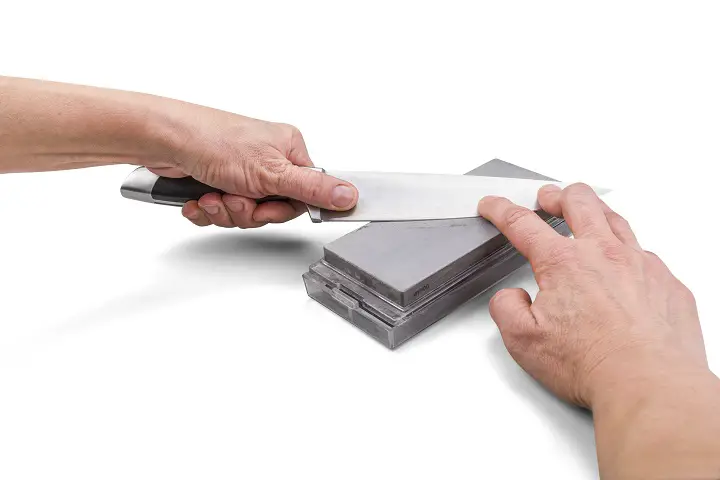
How do you sharpen a serrated electric knife?
Serrated electric knives can be expected to remain sharp for quite a long time. However, you still need to sharpen its serrated edges eventually as neglecting these parts may cause the knife to be unable to perform its function more effectively. One effective tip is to use an electric sharpening tool, although you have to make sure whether it perfectly suits your blade before buying first.
You can choose to buy sharpening tools specifically designed for knives with serrated blades. Also, ensure that your chosen electric sharpener can handle the specific type of blade built into your knife. Once you have picked an electric sharpener, you can start using it.
Just put the blade in between each sharpener’s rod, then push and pull your serrated electric knife back and forth. This movement can help bring back the sharpness of the knife within just a minute. You may also want to use a sharpening rod for the purpose of sharpening the knife.
Do knife sharpeners work on serrated knives?
Yes, there are various sharpeners that will work on serrated knives. Among those that you can use are electric sharpeners, ceramic honing rod, triangle-shaped sharpener, and square stone. You just have to figure out which one of these tools will work suitably for the serrated knife that you own.
How do you sharpen a serrated knife at home?
You can sharpen your serrated knife at home, provided you have a sort of a sharpening tool that will truly work for it. You can use a sharpening rod. Another alternative is a sharpening system that a lot of homeowners and home cooks prefer. This system lets you sharpen the knife manually.
It holds ceramic roots in a 40-degree angle at a V-shape. The only thing you have to do to make it work is to ensure that the knife stays steady while moving it down the triangular-shaped rod. You can then expect the rod to move between every gullet. The other ceramic rod can then be used on the flat part of the knife as a means of removing the burrs.
How long can a high-quality serrated knife go without sharpening?
A tactical watch should be waterproof, durable, and tough for it to be able to work for a long time. Your serrated knife also needs to be of top-notch quality and should be sharpened regularly for it to last for a long time. A high-quality knife can actually go for a long time without frequent sharpening, provided you use it properly.
It is because most of them have solid construction. Most of these quality knives can go on for years while delivering great performance, although you also need to have them sharpened once every 1 to 2 years or for really well-built ones, once every five years.
Conclusion
Whether you are using your serrated knife for your kitchen or for your adventures, like when you are in the wild or when hunting, it is necessary to learn something about sharpening it. You can also take a lunch cooler when going for a hike, hunt, or a camping adventure together with your serrated knife. With that, you can make your adventures more fun. Also, a rechargeable flashlight will come in handy as this, together with your knife, can make you fully prepared for what is in store for you when bringing it for recreational adventures.
Photos from: bodu10 / depositphotos.com, Berka777 / depositphotos.com, belchonock / depositphotos.com, KostyaKlimenko / depositphotos.com and lindo12345 / depositphotos.com.
